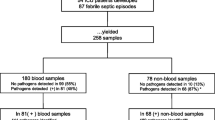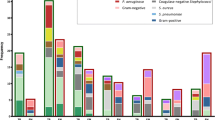Abstract
Bacterial translocation sometimes occurs in patients during surgical stress and is associated with an increased incidence of septic morbidity. However, no reliable method has been established for diagnosing bacterial translocation in humans. Identification of minute quantities of microbial-specific DNA has been made possible using polymerase chain reaction (PCR) techniques. The aims of this study were to determine the prevalence of bacterial translocation in patients with surgical stress using PCR techniques and to evaluate the usefulness of blood PCR techniques for diagnosing bacterial translocation. DNA was extracted from the blood of 52 surgical patients (24 elective major surgery patients and 28 septic patients) and 10 healthy controls. PCR techniques were used to amplify genes from Escherichia coli, Bacteroides fragilis, a region of 16S ribosomal RNA found in many gram-positive and gram-negative bacteria, and Candida albicans. Bacterial and Candida albicans DNA were not detected in healthy volunteers. Enteric bacterial DNA was detected in patients with hepatic lobectomy, and Candida albicans DNA was detected in patients with esophagectomy on the first postoperative day. Enteric bacterial and Candida albicans DNA were detected in septic patients with findings diagnostic of bacterial translocation, such as small bowel obstruction, ulcerative colitis, or supramesenteric arterial occlusion or in those who had undergone chemotherapy for advanced colon cancer. However, none of the patients were positive by the blood culture technique. The PCR method is more sensitive than blood cultures for detecting bacterial components in the blood of septic patients and is a valuable tool for verifying bacterial translocation in patients who have undergone hepatic lobectomy or esophagectomy. It is also valuable in septic patients who do not have a defined focus of infection.


Similar content being viewed by others
References
J Alexander S Boyce G. Babcock (1990) ArticleTitleThe process of microbial translocation Ann. Surg. 212 496–512 Occurrence Handle2222015
R Wichurch J Thupari A. Munster (1987) ArticleTitleEndotoxemia in burn patients: levels of circulating endotoxins are related to burn size Surgery 102 808–812 Occurrence Handle3672321
E Deitch R Berg R. Specian (1987) ArticleTitleEndotoxin promotes the translocation of bacteremia from the gut Arch. Surg. 122 185–190 Occurrence Handle3545142
C Bernet M Garret B Barbeyrac Particlede et al. (1989) ArticleTitleDetection of Mycoplasma pneumoniae by using the polymerase chain reaction J. Clin. Microbiol. 27 2492–2496 Occurrence Handle2509513
A Brisson-Noel B Gicquel D Lecossier et al. (1989) ArticleTitleRapid diagnosis of tuberculosis by amplication of mycobacterial DNA in clinical samples Lancet 2 1069–1071 Occurrence Handle10.1016/S0140-6736(89)91082-9 Occurrence Handle2572798
TD Kane SR Johnson JW Alexander et al. (1996) ArticleTitleDetection of intestinal bacterial translocation using PCR J. Surg. Res. 63 59–63 Occurrence Handle10.1006/jsre.1996.0223 Occurrence Handle8661173
R Cursons E Jeyerajah J. Sleigh (1999) ArticleTitleThe use of polymerase chain reaction to detect septicemia in critically ill patients Crit. Care Med. 27 937–940 Occurrence Handle10.1097/00003246-199905000-00029 Occurrence Handle10362416
ASCC. Committee (1992) ArticleTitleAmerican College of Chest Physicians/Society of Critical Care Medicine Consensus Conference: definitions for sepsis and organ failure and guidelines for the use of innovative therapies in sepsis Crit. Care Med. 20 864–874 Occurrence Handle1597042
T Morita S Tanaka S Nakamura et al. (1981) ArticleTitleA new (1–3)-β-d-glucan-mediated coagulation pathway found in Limulus amebocytes FEBS Lett. 129 318–321 Occurrence Handle10.1016/0014-5793(81)80192-5
DA Relman TM Schmidt RP MacDermott et al. (1992) ArticleTitleIdentification of the uncultured bacillus of Whipple’s disease N. Engl. J. Med. 327 293–301 Occurrence Handle1377787
RDD Croy (1992) Plant Molecular Biology Labfax Bios Scientific Abingdon, UK
Y Yamashita S Kohno H Koga et al. (1994) ArticleTitleDetection of Bacteroides fragilis in clinical specimens by PCR J. Clin. Microbiol. 32 679–683 Occurrence Handle8195378
D Isaacman Y Zhang J. Rydquist-White (1995) ArticleTitleIdentification of a patient with Streptococcus pneumoniae bacteria and meningitis by polymerase chain reaction Mol. Cell Probes. 9 157–160 Occurrence Handle10.1006/mcpr.1995.0026 Occurrence Handle7477007
N Woodcock V Sudheer N El-Barghouti et al. (2000) ArticleTitleBacterial translocation in patients undergoing abdominal aortic aneurysm repair Br. J. Surg. 87 439–442 Occurrence Handle10.1046/j.1365-2168.2000.01417.x Occurrence Handle10759739
N Vo D. Cji (1988) ArticleTitleEffect of hepatectomy on the reticuloendothelial system of septic rats J. Trauma 28 852–854 Occurrence Handle3385833
X Wang V Soltesz R Andersson et al. (1993) ArticleTitleBacterial translocation in acute liver failure induced by 90 per cent hepatectomy in the rat Br. J. Surg. 80 66–71 Occurrence Handle8428299
T Tani K Hanasawa Y Endo et al. (1997) ArticleTitleBacterial translocation as a cause of septic shock in humans: a report of two cases Surg. Today 27 447–449 Occurrence Handle9130349
T Obayashi M Yoshida T Mori et al. (1995) ArticleTitlePlasma-beta-d -glucan measurement in diagnosis of invasive deep mycosis and fungal febrile episodes Lancet 345 17–20 Occurrence Handle10.1016/S0140-6736(95)91152-9 Occurrence Handle7799700
Author information
Authors and Affiliations
Corresponding author
Rights and permissions
About this article
Cite this article
Ono, S., Tsujimoto, H., Yamauchi, A. et al. Detection of Microbial DNA in the Blood of Surgical Patients for Diagnosing Bacterial Translocation. World J. Surg. 29, 535–539 (2005). https://doi.org/10.1007/s00268-004-7618-7
Published:
Issue Date:
DOI: https://doi.org/10.1007/s00268-004-7618-7




